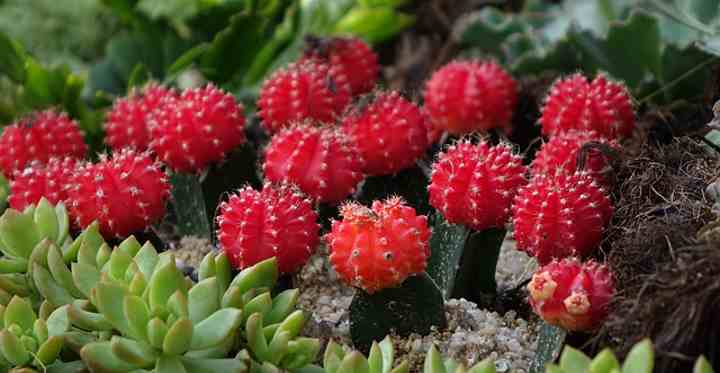Moon cactus, or Gymnocalycium mihanovichii, is an enchanting species revered for its unique appearance, most notably its vibrant, colorful top grafted onto a green cactus base. The juxtaposition of the bright, almost luminescent crown against the lush green base captivates enthusiasts and casual observers alike. This article delves into the intricacies of maintaining a fully grown moon cactus, underscoring why it is a perennial favorite among succulent aficionados.
Whether you are an avid horticulturist or a novice plant keeper, understanding the essentials of moon cactus care is paramount to ensure that your plant thrives and retains its striking aesthetic appeal. The enchanting colors of the moon cactus arise from its lack of chlorophyll, making it an intriguing subject for those drawn to the unusual and exotic.
In this exploration, we will cover various facets of moon cactus care, including lighting conditions, watering practices, and repotting considerations. Furthermore, we will discuss pest management and propagation techniques, which will enhance your understanding and appreciation of this fascinating plant.
Understanding the Optimal Light Conditions
Moon cactus revels in bright yet indirect light. Finding the right balance can be crucial. Direct sunlight can scorch its delicate top, leading to unsightly discoloration or deterioration. A south-facing window with filtered light is an ideal setting. In contrast, insufficient light can lead to stunted growth and a fading of the vibrant colors that make these plants so captivating.
During the winter months, the plant may require additional light as the days grow shorter. Employing grow lights can also ensure that your moon cactus receives sufficient illumination throughout the year, promoting healthy growth and robust coloration.
Maintaining the perfect light environment essentially addresses the common observation that vibrant colors signify a healthy plant. The colors often mirror the vitality and overall health of the moon cactus.
Watering Wisely: The Heart of Moon Cactus Care
Watering is one aspect that many plant lovers struggle with, especially when caring for succulents like the moon cactus. A golden rule of thumb is to water only when the soil has completely dried out. Overwatering can lead to root rot, a menace that can quickly obliterate your cactus. Conversely, underwatering may induce desiccation, causing the plant to wither and lose its luster.
During the growing season, typically spring through summer, a thorough watering every two to three weeks is adequate. In fall and winter, when growth slows, reduce watering frequency to maybe once a month, or even less, depending on environmental conditions. Always ensure pots have proper drainage! This prevents water accumulation in the roots, aligning with the moon cactus’s native environment, where they thrive in arid, well-draining soils.
The Fascinating Science of Soil and Fertilization
Soil selection plays a pivotal role in the care and longevity of your moon cactus. A gritty, well-aerated cactus mix, often containing sand, perlite, or pumice, fosters optimal drainage. Additionally, a slightly acidic to neutral pH range is preferred. Paying attention to soil composition is crucial. It reinforces the deeper fascination with cacti by showcasing how they have adapted to their environment over millennia.
Fertilization can further enhance your plant’s health and vigor. During the growing season, applying a diluted, balanced, water-soluble fertilizer can help sustain growth and maintain the bright colors. Avoid over-fertilizing, as this can lead to mineral buildup and detrimental effects on the cactus. Fertilization is a reminder that, although moon cacti thrive in marginal conditions, they still benefit from the right nutrients.
Repotting: When and How to Do It
Proper repotting techniques are vital for maintaining a healthy moon cactus. Typically, these plants should be repotted every two to three years or when growth appears stunted. The best time for repotting is during the spring, coinciding with the start of the growing season. Choosing a pot that is slightly larger than the previous one allows for adequate root development, fostering further growth.
When repotting, handle the plant with care to prevent damage to the delicate crown. Avoid burying the plant too deep in the new soil; the graft union should remain above the soil line to ensure stability. This process allows a deeper appreciation for the moon cactus’s unique grafting, showcasing the intricate relationship between the ROOTstock and the SCION.
Addressing Pest and Disease Threats
Like any plant, moon cacti can fall victim to pests such as mealybugs or spider mites. Regularly inspecting your plant and employing insecticidal soap or neem oil can help mitigate these threats. Performance indicators like webbing or small white masses on the cactus can signal an infestation, signaling that timely intervention is crucial.
Infection and disease, while less common, can occur, particularly if the plant is subjected to unfavorable conditions. Root rot due to overwatering is a prevalent concern, while fungal infections can arise from excessive humidity. Keyword: prevention! Maintaining proper care and environmental conditions can thwart potential issues.
Propagation: Expanding Your Moon Cactus Family
Propagating moon cacti may not be the most conventional approach due to the peculiarities of grafting. Nevertheless, it is possible to grow new plants through the offsets that may appear around a mature cactus. These offsets can be removed and replanted once they establish roots. Understanding propagation not only allows a continued immersion into the plant but also extends its legacy.
In conclusion, caring for a moon cactus invites enthusiasts to explore the delicate balance between nature and nurture. By addressing the plant’s fundamental needs and uncovering the reasons behind its colorful allure, one can appreciate this extraordinary specimen on a deeper level. With the right care, a full-grown moon cactus can thrive, adding a touch of vivacious beauty to any collection or space.





Leave a Comment